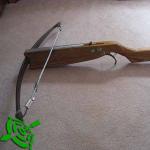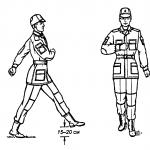Tips for a beginner skateboarder. Skateboarding records The maximum speed that a speed skateboard can achieve
The development of electric skateboards does not stand still. Companies like Acton and Revoll have already made carbon fiber boards equipped with all-wheel drive. This won't surprise anyone anymore. But the engineers at Carvon decided to raise the bar even higher and make a truly fast board with an electric motor.
California-based Carvon is not a new player in the electric skateboard market and has been producing them for about five years. But now she's started a Kickstarter campaign to raise funds for a truly unique board.

Typically, Carvon electric skateboards have separate motors for each wheel, but in this case, the board is equipped with a dual V3 Dual Direct Drive motor. The company explains that the new engine layout allows for thicker wheels, which ultimately reduces the load on the engines.

Carvon has developed a 100cm Revo 4WD skateboard made from multiple layers of carbon fiber. At the same time, the board has an unusual shape in the form of an arch - this was done specifically so that when riding, a person would be as close to the ground as possible for more vivid sensations.

What makes this board stand out is its performance. The skate can accelerate to a maximum speed of 55 km/h, and also has faster acceleration dynamics than any other electric board. On one battery charge it can travel up to 32 km.

As an added bonus, the Revo 4WD has removable wheels. The board comes complete with 97mm polyurethane wheels and 7-inch air-inflated tires for off-road riding. An electric skateboard weighs about 10 kg.

There is also a simpler and cheaper electric skateboard called the Evo, which uses the same board but has a slightly weaker dual motor. It can accelerate to a top speed of 48 km/h) and can climb inclines of up to 15 degrees. This skate weighs 7.5 kg and can travel 22.5 km on a single battery charge.

Instead of using a traditional electric board remote, Carvon has developed a handheld controller that straps onto the back of your hand and is controlled by your thumb.

Carvon's electric skates are currently available for pre-order at $999 for the Evo and $1,499 for the Revo 4WD. At retail they will already be more expensive (Evo will cost $1,499, and Revo 4WD will cost $1,999).
For fans of unique Vehicle worth paying attention to.
The development of high-speed skateboarding and the growth of its popularity are encouraging manufacturers to develop new, more advanced types of boards for this sport. A speed skateboard is not only different appearance, but also many other design parameters that help the rider on such a board develop high speed.
The maximum speed that a speed skateboard can achieve
In high-speed skateboarding, longboards are used. The length of the deck of such boards can be from 100 cm or more. The axles of the longboard are spaced as far apart as possible. Wheel diameter - 65-75 mm. The most suitable degree of rigidity of rollers for high-speed skates is considered to be 78A - 85A.
Wheels peeking out lateral lines soundboards This design reduces the maneuverability of the longboard, but allows it to be as stable as possible and cope with high speeds. In addition to this, you need a good shock-absorbed suspension to comfortably overcome unevenness on the asphalt and extend the life of the board.
The maximum speed of a skateboard depends on what type of unit it is. A downhill skate with a deck length of about 1 m is the best for downhill riding. This skate is characterized by high rigidity, increased suspension and a small turning angle. Such parameters allow you to maneuver as smoothly as possible at high speeds. Downhill downhill can be accelerated to approximately 140 km/h.

The potential maximum speed of freerides and slides is almost equal to that of downhill boards, but the design of the wheels allows such boards to demonstrate controlled skidding.
Rigid and straight slalom boards 60-70 cm long have good controllability, but they cannot withstand a long distance of descent from the mountain, and their maximum speed is lower.
A hybrid board is a development that uses the average parameters of a cruiser and a slalom board. The length of the deck of such a device is 70-80 cm, which allows the hybrid to be more maneuverable compared to a carving board and develop speed, the maximum values of which are higher than that of a slalom skate.
Skate speed records
In 2007, the world learned about the fastest skateboarder - Douglas Da Silva. On his board he was able to reach speeds of up to 113 km/h.
In 2010, Canadian Michaud Herban from Quebec managed to accelerate on a board on a highway descending to the St. Lawrence River, with a slope of 18°, to 129.94 km/h.

Eric Lundberg on his skateboard achieved a speed of 0.06 km/h, exceeding Erban's record result. American Kyle Wester from Denver broke the speed record on a skateboard set by Lundberg in 2016. On his board, he was able to go down the hill at a speed of 143.9 km/h.
Incredible tricks and speeds that the board is capable of in skillful hands
Skateboarding records
Incredible stunts and speeds,
what the board is capable of
in capable hands
Who would have thought that this small board on four wheels, with all its apparent frivolity, is capable of producing some unimaginable things, which can only be understood using the language of numbers. Of course, no one says that you can’t just skateboard or ride along the alleys, occasionally grinding curbs and jumping over pits, without even thinking about any world records. Can! Well, about those who went even further and forced the board to set a record with their own feet, you will learn below.







The tallest ollie
In skateboarding, the ollie is considered a basic element that forms the basis of most tricks, but this seemingly simple element can be turned into a real feat. In 2011, at the finals of the Maloof High Ollie Challenge in Las Vegas, Aldrin Garcia set a new world record by lifting his skateboard 114 cm from the ground, thereby breaking a record that had stood for 10 years. Two years later, Austrian Bernd Tretting raised the bar to 115 cm, but his record remained unofficial.

Higher and further
It’s difficult to say when the history of skateboarding began, but the first thing that comes to mind is the king of mega-ramp, one of the founders of the DC brand, Danny Wei, who once jumped over the Great Wall of China. In 2004, at the Skateboarding Big Air contest, this madman, accelerating to 88 km/h, flew a record 24 meters, soaring up 7 meters.

Rotations on the ground
“Richie Carrasco completed 142 continuous spins on the rear suspension.”
Richie Carrasco is not even an old star, but rather a ancient school skateboarding, from the distant 70s. Therefore, the record of this slalom master will seem strange and far from the current one to current skateboarders. modern sports. 142 continuous rotations on the rear suspension - even ballerinas and figure skaters will envy such a vestibular apparatus!
Maximum speed
To understand what kind of speed this is, imagine that you are riding on a commuter train at the moment of its maximum acceleration, and a man in a motorcycle suit without a motorcycle, standing on a longboard, flies past your window. Introduced? So this guy could well be Michaud Herban, who accelerated to a record 130 km/h on a regular highway with an 18-degree slope in Quebec.

Spins in the air
“At the age of 12, Tom Schaar did a 1080-degree spin.”
They say that when Tony Hawk saw a 1080-degree rotation beyond his control performed by some brat Tom Shaar, he involuntarily reached for a pack of sleeping pills, but in time he remembered his wife and children. First, Tom became the youngest athlete to hit 900 degrees on a megaramp, and only then, at the age of 12, he did 1080, defeating skateboarding veterans. By the way, Tom often repeats the trick.

The biggest skate
“The weight of a 16-meter replica of a normal skateboard is 1620 kg”
No, not made of bread or Lego bricks, but a real giant skateboard with all the necessary details and options. The weight of a 16-meter copy of a normal skateboard is no less than 1620 kg. The giant board was built by the director of several California skateparks, Joe Ziagli, and Rob Dyrdek, who is also included in our selection of record holders below.

Longest slide
It might seem that Rob Dyrdek is one of the most record-loving skateboarders. In total, he holds 21 world records, some of which, however, have already been broken. Along the way, he manages to host a show, film his own, support his charitable foundation, and much more. Our selection included an active skater with the longest slide on a skateboard on a rail or, if you prefer, with a 30-meter trick 50/50 rail grind! When watching the video, at some point it begins to seem that this is the hero of Tony Hawk's game, stuck in the textures.
Let us remind you that all the tricks you saw were performed by professional slackers, crazy people and just skaters. Don’t try to repeat this at home, and as the voice on the subway says: “Go to college, find an interesting job...”
Skateboarding is extreme view a sport whose essence lies in masterfully performing tricks on a special board - a skateboard. It originated quite a long time ago - back in the 30s of the last century. Surf lovers came up with this kind of entertainment so that in the absence of waves on the coast they would not be bored without their favorite entertainment. Since the surfboard is quite large, they got it first. And then they noticed that it was much more convenient to perform tricks on a shorter and more manageable board. Since then, people began to skateboard.
IN last years Skateboarding is gaining popularity among young people, turning from simple entertainment into a real subculture, with its own music, clothing style, behavior and ways of spending leisure time. And also, quite recently, it was recognized as an official sport, a set of rules and its own were created. International Association Skateboard Companies.
On June 21, the official holiday of fans of this sport is held - International Skateboarding Day. So, tricks on the board have proven themselves from the most serious side. And every year the number of admirers and enthusiasts of this sport is steadily growing.
Moscow climbing walls offer routes for professional climbers.
A hang glider with a motor is correctly called a hang glider. read our article.
Basic Skating Styles

- Flatland(from English “flat earth”) - the very first style, which involves skating and performing various tricks on a horizontal surface - asphalt, concrete slabs.
- Straight– as the name implies, this is a style of street skating in which all kinds of stairs, railings, ceilings, and bump stops become the basis for tricks. This is the style that most skaters currently ride in.
- Freestyle- a very popular style in the 70-80s, in which tricks were required to be performed exclusively on one plane.
- Vert- a style that originated in 1976 thanks to the Z-Boys - due to the drought, they began to skateboard and do tricks in dry swimming pools. This is a style of ramp stunts.
- A park- the successor of vert in performing tricks on the ramp, but now in skate parks specially created for this, where special ramps have been built for performing especially spectacular and complex elements.
Whatever style you would like to learn how to master, this process for a beginner will be labor-intensive and quite expensive, since correct skating Skateboarding begins with the selection of high-quality and comfortable equipment: a board, comfortable shoes, spare parts for a skateboard.
High-quality and comfortable equipment
The most important asset of a skater is his board, or board in Russian. For beginners good choice will be the purchase of the so-called American kit, which includes the following components:
- tracks (suspensions) and shock absorbers
- wheels
- bearings
- griptape
- keys, bolts for fastening

Without question, all these components must be selected only in specialized stores and after consultation with the seller, who will be able to select the right combination of parts for a particular skateboarder. But general rules there are also options to choose from, and it’s worth finding out about them in advance.
The board is the most important component of a skateboard. But it is also the most short-lived - as you increase your skating skills, you will have to change it quite often.
The board is usually made of several layers of Chinese or Canadian maple wood, glued together. The quality of the glue determines whether the deck will delaminate. In some models intended for street, another plastic layer (slick) is glued along the bottom of the board, which provides the board with good glide along the railings.
How to choose a board so as not to end up with a defective or dry copy? The easiest way is to chat on a skaters forum and ask someone experienced to help with your choice. But if this option is unrealistic, you will have to act yourself.
How to choose a skateboard yourself
If you decide to choose a skateboard for yourself or for a child, what you need to pay attention to:
Deck width. It can range from 4.7 to 10.625 inches. For beginners, an eight-inch board will be the best choice, and as you learn, you can easily understand whether it is suitable, or whether a wider or narrower board is required. A wider deck gives stability and better traction. Narrow - more maneuverability.
From board length The difficulty of the ride is practically independent, and therefore you can choose any one. The standard is 31 inches (78.7 centimeters). For very young skateboarders, they produce smaller models - mini-skateboards. Also, in general, for beginners it does not affect the complexity and bend of the board (concave) - its convenience is determined only by experience.
When choosing, you need to carefully inspect the board for transverse cracks - this is a sign of defective material. But longitudinal cracks in the area of the bolts are not so bad - they appear on almost all boards in the first week of riding. The most famous brands boards is Mystery, Jart, Toy Machine, Almost— if you have no experience at all in choosing boards, it is better to focus on them.
The next part of the board is pendants. They are selected depending on the width of the deck; wheels and bearings are attached to them. Suspension stiffness is adjustable for different riding styles. Material: aluminum. Sometimes you can find a steel pendant; it is more durable, but also heavier.
Wheels There are a wide variety of types for skateboards. For beginners, you should choose regular, medium-sized hard wheels. Their size ranges from 50 to 180 millimeters. Standard 54mm wheels are optimal. You should remember that you will have to change them often - the wheels wear out quickly when riding.
An important part of the kit - bearings. You shouldn’t skimp on them, since both the speed of the skateboard and the safety of the skateboarder themselves depend on their quality. Therefore, it is better to avoid buying Chinese consumer goods, and look for bearings from brands such as Fkd, Lucky or Cliche. In addition, bearings differ by number ABEC(Annular Bearing Engineering Council): 1 and 3 are low-class bearings for beginners, 5, 7 and 9 are for professionals.
Skin or grip tape- This is a film that provides adhesion between the board and shoes. You can already choose it based on your taste preferences - with or without a pattern; no one has ever started skating better based on its color.
It is also important to choose the right shoes for riding. These can be sneakers or sneakers - depending on personal preferences. But in any case, it is better to choose brands that are specially designed for skateboarding and are sold in specialized stores. And, of course, they must be comfortable and the right size.
All these components form a single set, which, if selected correctly, will greatly facilitate the acquisition of skateboarding skills.
You can learn how to tie the main ones by reading the article at the link.
Before you go on a road trip, read about what camping is.
Let's figure out how a beginner can learn to skateboard
 In beautiful videos, skateboarders may appear to perform difficult tricks with ease. However, you need to understand that performing difficult tricks on a skateboard comes at the cost of long and patient training, as well as bruises and abrasions. Therefore, the first advice is buy protection. You will need a helmet to protect your head, knee pads, elbow and palm protection. A properly selected protective kit will not cause much inconvenience. It will be much more inconvenient with broken knees and palms!
In beautiful videos, skateboarders may appear to perform difficult tricks with ease. However, you need to understand that performing difficult tricks on a skateboard comes at the cost of long and patient training, as well as bruises and abrasions. Therefore, the first advice is buy protection. You will need a helmet to protect your head, knee pads, elbow and palm protection. A properly selected protective kit will not cause much inconvenience. It will be much more inconvenient with broken knees and palms!
After choosing your equipment, you should get used to the skateboard. To do this, you need to put it on a flat surface and learn to balance on it, stand, choose a comfortable body position, try to move your legs and rearrange them.
Then you need to understand Which foot will be in front - left or right?. This does not necessarily depend on whether the person is left-handed or right-handed. To do this, you can try kicking any ball with your foot - the one with which it is more convenient to do this has a high chance of ending up behind you and becoming a supporting one. Another way to test this is to push the person. The leg that he puts forward when pushing will be the supporting leg on the skateboard.
After correct setting You can slowly begin to master movement and stopping on a skateboard. This process is long and will most likely be accompanied by falls, but with the right board and a properly positioned supporting leg, progress in skating will be noticeable quite quickly. Therefore, you should not be shy, not afraid to fall, and boldly ride first on a flat surface, then slowly learn to turn and overcome barriers. It’s best to do all this at skate sites, and best of all, not alone - in a company and with music, learning will be more pleasant and fun.
Photos of interesting skateboards








